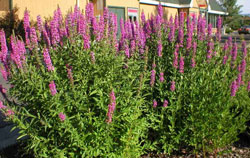Purple loosestrife
Lythrum salicaria L.
Keys to Identification
- Purple loosestrife is a perennial introduced from Europe. The erect, square stem can be smooth to hairy, multi-branched and 1-1/2 to 8 ft tall. The leaves are lance shaped, entire, and are whorled. The magenta-colored flowers, which have five to seven petals, are arranged in long racemes.
- Purple loosestrife can be found in moist wetland sites throughout the state. It is a highly aggressive invader species. If left unchecked, a wetland will eventually become a monoculture of loosestrife. This plant poses a severe threat to waterfowl habitat and can impede water flow in irrigation ditches.
This information courtesy of the Colorado Natural Areas Program
Family
Loosestrife (Lythraceae)
Other Names
Prple lythrum
USDA Code
LYSA2
Legal Status
Colorado Noxious Weed List A
Identification
Lifecycle
Perennial
Growth form
Forb or woody sub-shrub.
Flower
Flowers are purple with 5-7 petals arranged in long vertical racemes.
Seeds/Fruit
Fruits are many-seeded capsules, seeds are small and ovoid.
Leaves
Leaves are simple, entire, and opposite or whorled (Whitson et al. 1996).
Stems
Annual stems arise from a perennial rootstock (Mal et al. 1992). Stems are erect, and often grow 6-8 ft tall. Plants become taller and bushier over the years as the rootstock matures.
Roots
Short rhizomes and taproot.
Seedling
No information available.
Similar Species
Exotics
None known.
Natives
Sometimes confused with fireweed (Epilobium spp.), which have 4-petaled flowers.
Impacts
Agricultural
No information available..
Ecological
Purple loosestrife is an ornamental species that often escapes to sites such as streambanks or shallow ponds. The invasion of purple loosestrife leads to a loss of plant diversity, which also leads to a loss of wildlife diversity (Bender and Randall 1987). Purple loosestrife germinates at such high densities that it outcompetes native seedlings. Infestations can become dense and impede water flow in canals and ditches. When placed under moisture stress, purple loosestrife may produce additional roots, which may give it a competitive advantage over other species.
It is an aggressive invader of wetlands. Once it is established, it often displaces native wetland species and degrades wildlife habitat. If purple loosestrife is left unchecked, the wetland eventually becomes a monoculture of loosestrife (Bender and Randall 1987). Where purple loosestrife is competing with cattails, it is favored by fluctuating water levels because marsh drawdown aids in seedling establishment (FEIS 1998). However, where water levels remain constant and relatively deep, cattails may be able to outcompete purple loosestrife (FEIS 1998).
Habitat and Distribution
General requirements
Purple loosestrife usually occurs in marshes, wet meadows, stream margins, shores of lakes and wetlands. Purple loosestrife can tolerate a wide range of conditions (up to 50% shade), can grow on calcareous and acidic soils (Rutledge and McLendon) and will even grow in standing water.
Distribution
In Colorado, purple loosestrife is known to occur in the Denver/Boulder area and downstream along the South Platte River, in Mesa County along the Colorado River, in Montrose County near Nucla, in Otero County near the Arkansas River, and in Colorado Springs. It is not known if purple loosestrife has upper elevational limits, but since it grows successfully in Canada, it should be considered a threat at higher elevations in Colorado.
Historical
Purple loosestrife is a native of Eurasia and was first recorded in America in 1814 (Bender and Randall 1987).
Biology/Ecology
Life cycle
Purple loosestrife begins its growth about a week to 10 days after cattail and reed canarygrass. Spring established seedlings grow rapidly and produce flowers 8 to 10 weeks after germination. After flowering, each stem supports a dense spiraling row of dark-brown seed capsules.
Mode of reproduction
Purple loosestrife is a perennial that reproduces by seeds and rhizomes. The rootstalk of purple loosestrife is the main organ of local propagation; therefore, wide vegetative spread is unlikely. However, detached root or stem fragments can take root and develop into flowering stems (FEIS 1998).
Seed production
A single flowering stalk can produce 300,000 seeds, and densities as high as 80,000 stalks per acre have been recorded (FEIS 1998).
Seed bank
Purple loosestrife seeds may remain viable for up to 20 years.
Dispersal
Seeds are mainly distributed by water, but can also be dispersed by animals and humans. Seeds do not drop from capsules until the air temperature becomes cold in the early fall.
References
Bender, J. and J. Randall. 1987. Element Stewardship Abstract for Lythrum salicaria, Purple loosestrife. The Nature Conservancy. Internet 2/5/99. Available: http://www.tncweeds.ucdavis.edu/esadocs.htm
FEIS – Fire Effects Information System [Online] (1996, September). Prescribed Fire and Fire Effects Research Work Unit, Rocky Mountain Research Station (producer), US Forest Service. Available: www.fs.fed.us/database/feis/ [1998,March 12]
Mal, T.K., J. Lovett-Doust, L. Lovett-Doust, and G.A. Mulligan. 1992. The biology of Canadian weeds. 100. Lythrum salicaria. Canadian Journal of Plant Science 72:1305-1330.
Rutledge, Chris R. and Dr. Terry McLendon. No Year. An Assessment of Exotic Plant Species of Rocky Mountain National Park. Department of Rangeland Ecosystem Science, Colorado State University. 97pp. Northern Prairie Wildlife Research Center Home Page. http://www.npwrc.usgs.gov/resource/othrdata/explant/explant.htm (Version 15DEC98).
Whitson, T.D.(ed.), L.C. Burrill, S.A. Dewey, D.W. Cudney, B.E. Nelson, R.D. Lee, R. Parker. 1996. Purple loosestrife. Weeds of the West. Western Society of Weed Science, in cooperation with the Western United States Land Grant Universities Cooperative Extension Services, Newark CA. pg. 380.

